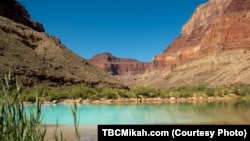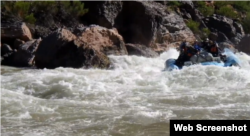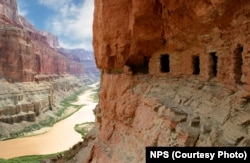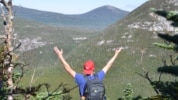The Grand Canyon — one of the Seven Natural Wonders of the World — is one of nature’s most stunning creations.
Located in the southwestern state of Arizona, the majestic site has inspired adventurers, poets and painters for hundreds of years. Whether looking down from its massive rim or up from the rushing waters of the Colorado River, it's easy to see how it got its name.
National parks traveler Mikah Meyer, who’s on a mission to see all 417 National Park Service sites, can see why.
“It’s grand! That's the right word to use for it,” he said. “Because whether standing at the rim and overlooking it or being down on the river, you just get a sense of how massive the Grand Canyon is."
Shaped by millions of years of erosion, the distinctly colored canyon is 446 kilometers (277 miles) long and averages about 1,220 meters (4,000 feet) deep — the length of 11 football fields.
Unique geology
“What's so unique is that you have all these layers of the earth that were once underground that have been uplifted and then eroded away so scientists can see millions and millions and millions of years of earth's crust history,” he said.
Scientists and visitors both can explore the massive canyons by foot … and by boat.
Which is what Mikah did on an eight-day, 362 kilometer (225 mile) rafting trip on the Colorado River, courtesy of Grand Canyon Whitewater.
“I wouldn’t call it ‘glamping,’ but definitely, if you're going to float down the Colorado River and be stuck in the Grand Canyon with no access to anything from the outside world, then this was a great way to do it!”
The Colorado River is a massive stretch of water that passes through seven states and has carved the land in four of them.
One of Mikah’s favorite experiences was a side trip to the Little Colorado River, a tributary just off the main river.
“What made this Little Colorado so special is that it was an almost baby blue, light blue-white color, and you see the moment where it converges with this dark gray Colorado River, and these two vastly different colors coming together.”
Mikah described how he and his fellow travelers, “who were mostly in their 50s,” were “giggling and laughing like 10-year-olds” as they hooked their feet under each other's armpits so they could float down the Little Colorado in a chain.
The group also took turns standing under one of the river’s many waterfalls, which they could access from the front and through a narrow passageway from the back.
“It was just this amazing side trip that showed you the wonders of the Grand Canyon that are hidden deep within, that you won't discover unless you go in it,” he said.
Nature’s roller coaster
And while there are places on the river where the water is still, and where you can see mist rising from naturally formed springs, the highlight for Mikah was navigating the whitewater rapids that the river is famous for, including Lava Falls, the scariest rapids in the park.
“It is one of three ‘10s’ in the Grand Canyon, meaning the most difficult to navigate for the guides and by and large considered the most epic of all the whitewater,” Mikah explained.
“So we’re all zipped up in rain jackets and rain gear because the water is actually really cold … and so when it hits you, it's kind of a shock to the system…”
They were hit with several large waves.
“The first one kind of got everybody wet with a decent amount, and then the second wave felt like a brick wall hitting you … and there's just this moment where everyone's like ‘what just happened?’ and then everyone starts giggling and laughing and cheering and whooping and screaming because it's just so much fun! You're basically on a roller coaster except it’s a raft and you're going through water and you don't know what will happen next.”
“It's not like a Disney-designed ride where you’re guaranteed to be safe,” Mikah added. “You could be thrown off the raft.
“There’s a great triumphant experience to say you conquered the biggest rapid of this 225-mile stretch … it was just a really magical moment.”
Still waters and magic
During calmer moments, visitors can also learn about the river’s rich history. The National Park Service describes on its website how people “have been part of Grand Canyon's history and culture from 10,000 years ago through today."
Based on archeological evidence, the park service explains that hunter gatherers "passed through the canyon 10,000 or more years ago. The ancestral Puebloan people have lived in and around the canyon for several thousand years, leaving behind dwellings, garden sites, food storage areas, and artifacts. Modern tribes still consider the Grand Canyon their homeland."
During their river tour, Mikah and his fellow rafters had great views of historic Native American food storage granaries that have been carved into the canyon walls.
And there were opportunities to see some of the wildlife … like the endangered California condor, the largest flying bird in North America.
“They brought them to the Grand Canyon to try to provide a habitat that they thought would help them thrive and thus far it's been doing pretty well,” Mikah said.
“It was just so many of these little side hikes and experiences that brought this group of mainly retired people to acting like children again, and I think that's the magic of the Grand Canyon,” he added.
Glamping
In the evenings, Mikah and his group camped on the shore, where they had a chance to relax, put their feet into the water and enjoy hot meals like chicken fajitas and vegetables, specially prepared for them by their guides.
A perfect way to end each day in one of the world's most beautiful — and natural — playgrounds.
“The world could have gone to nuclear war for all we would have known,” Mikah reflected. “It was just this amazing moment to truly be in nature, truly be void of the distractions of the world and enjoy that splendor of nature, enjoy the people you're around in a way that is so rare today.”
Mikah invites you to follow him on his epic journey by visiting him on his website MikahMeyer.com, Facebook, Instagram, Twitter and YouTube.













